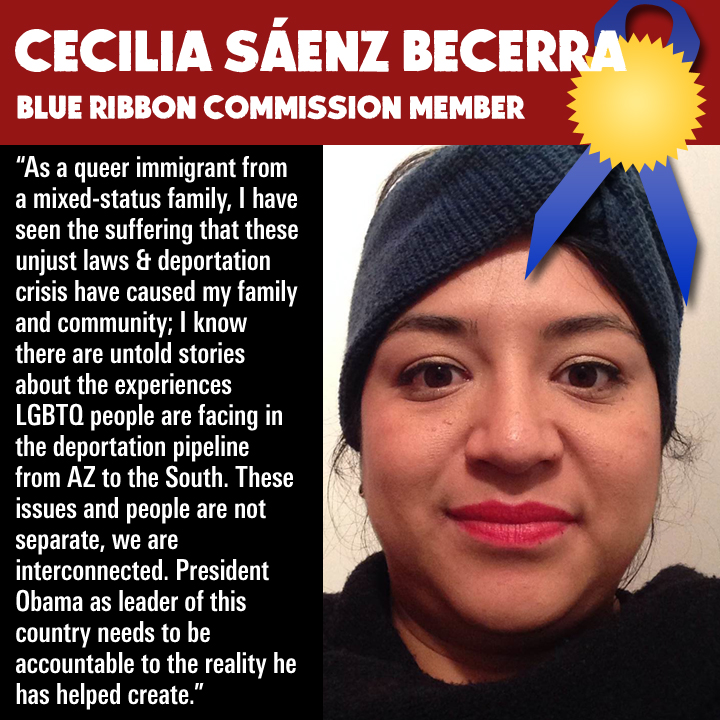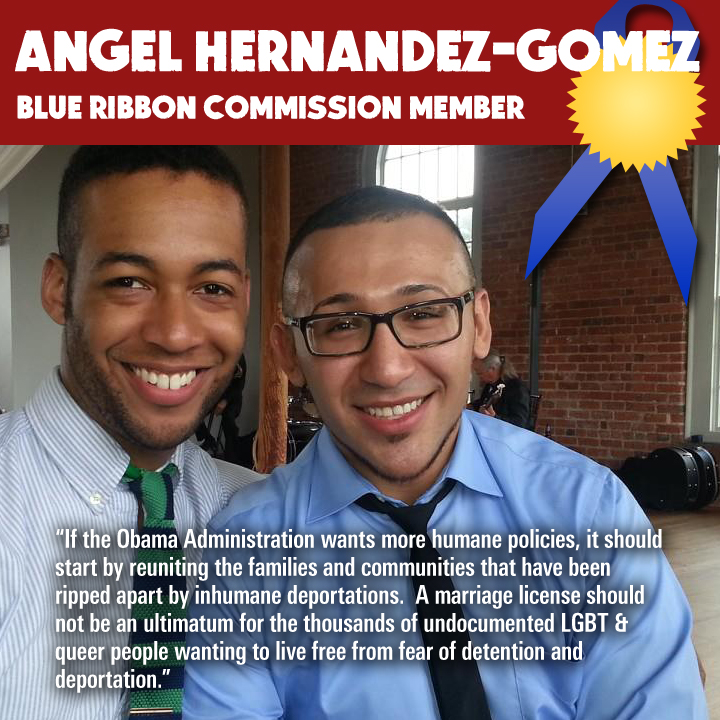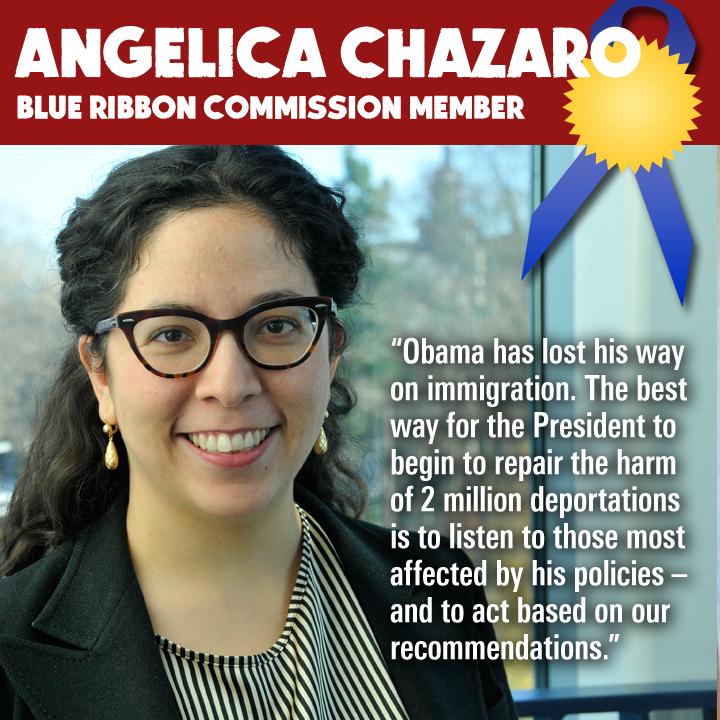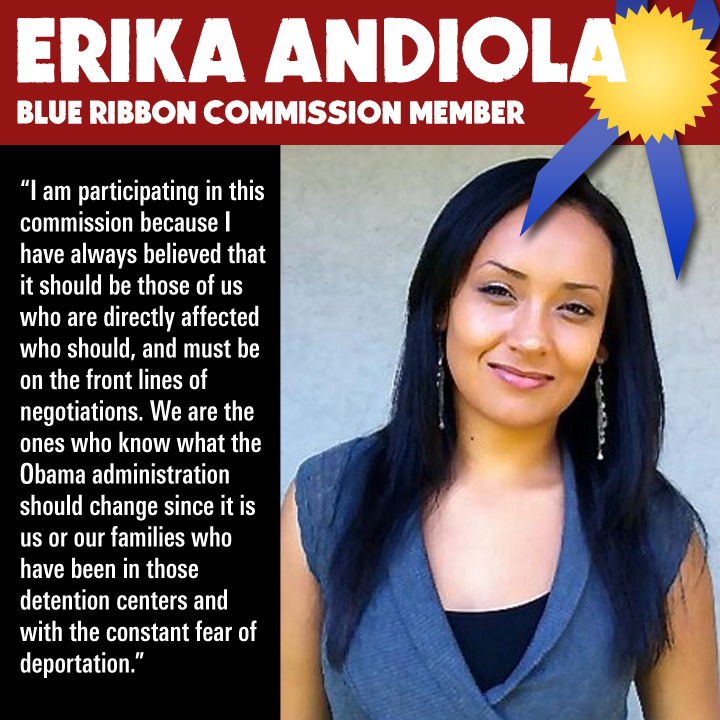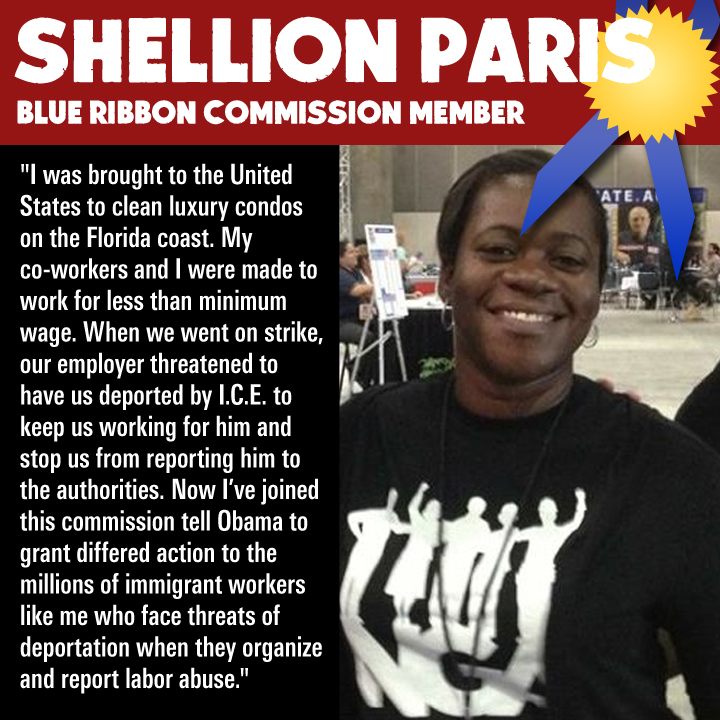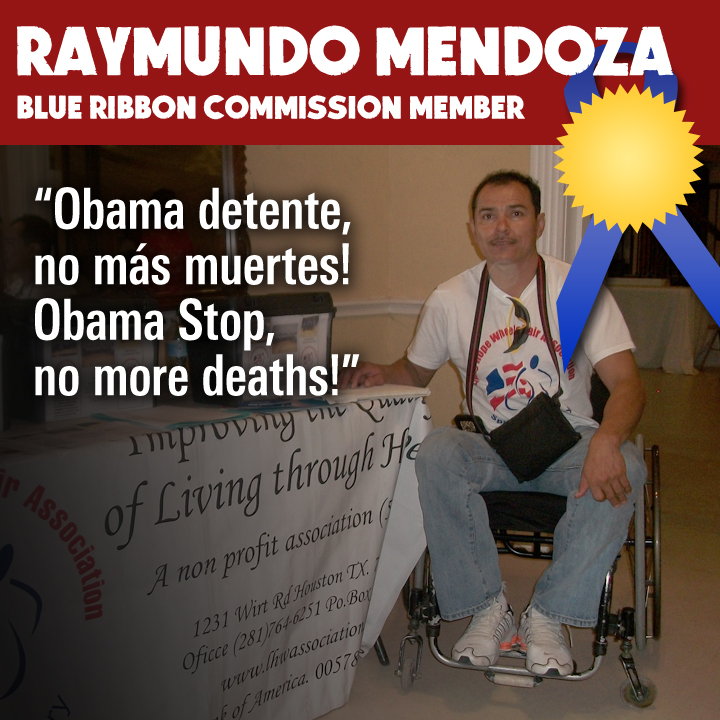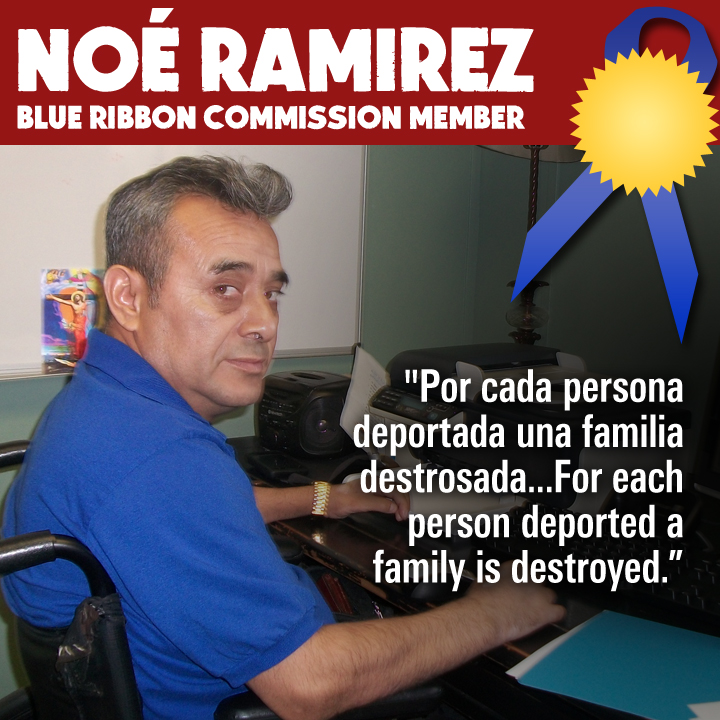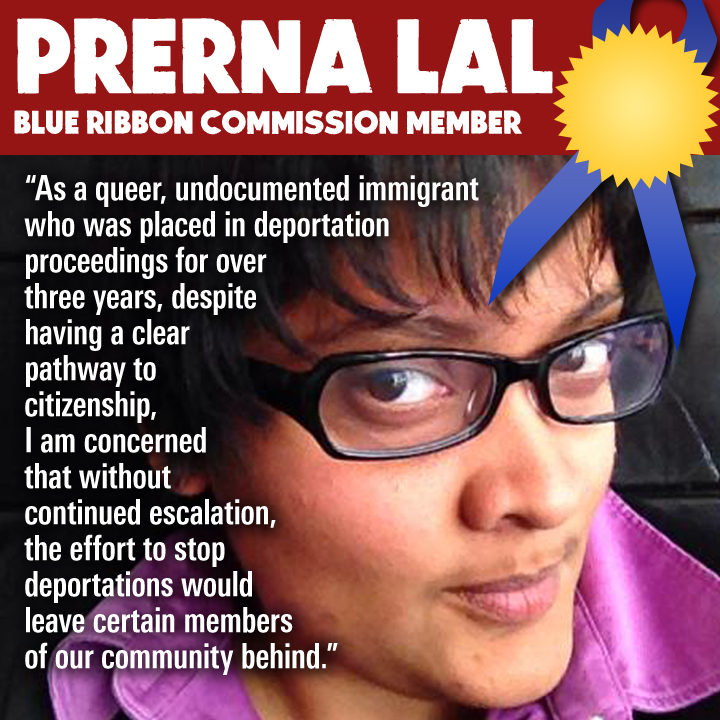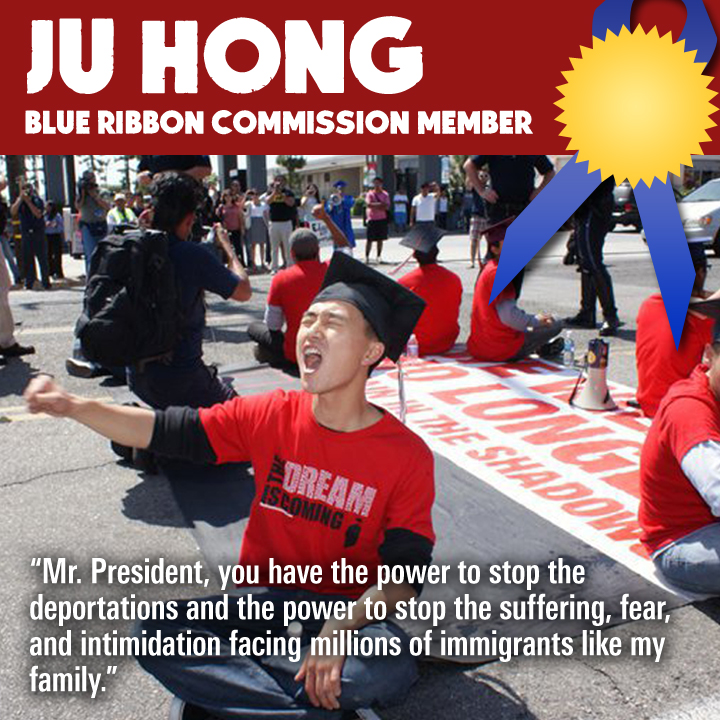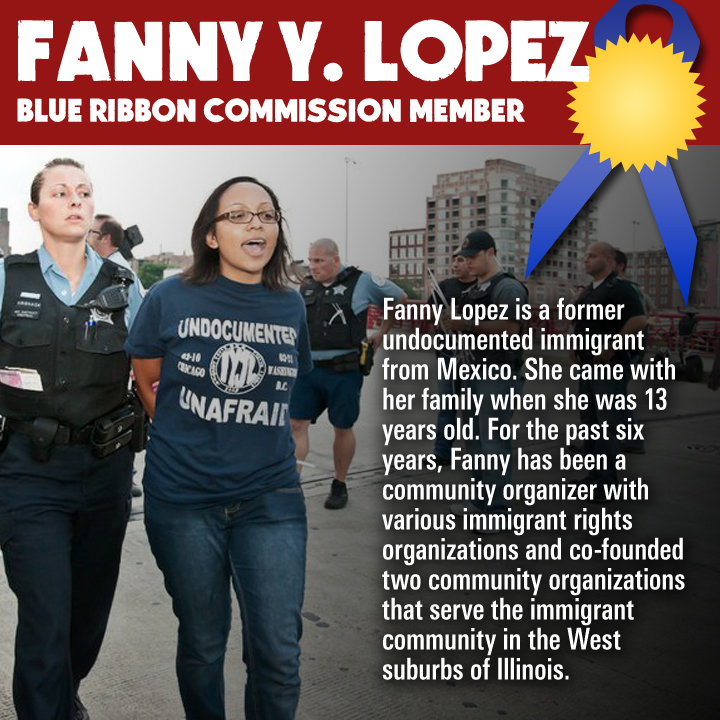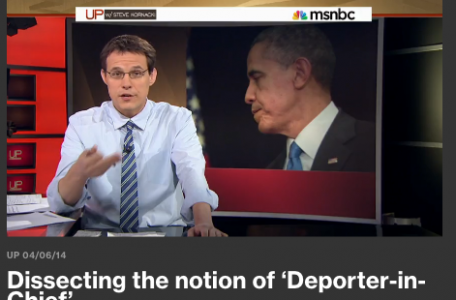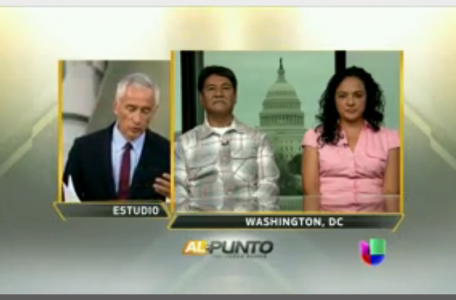- About
- Art
- Take Action
- Resources
- Donate
- Blog
All posts in April 5th News
Growing pressure on the Administration led to the President to announce instructions to DHS to review deportation policies with the aim to make them “more humane.” Parallel to the White House directive, former and currently undocumented immigrant leaders formed a Blue Ribbon Commission to perform an independent review and present its recommendations to the President, helping fill the noticeable lack of representation from those seeking legal status and citizenship in recently-convened White House meetings. They request a meeting with the President to discuss their findings and hear directly from those who are impacted by potential upcoming policy changes.
Dear Friends and Allies,
Growing pressure on the Administration led to the President to announce instructions to DHS to review deportation policies with the aim to make them “more humane.” Parallel to the White House directive, former and currently undocumented immigrant leaders formed a Blue Ribbon Commission to perform an independent review and present its recommendations to the President, helping fill the noticeable lack of representation from those seeking legal status and citizenship in recently-convened White House meetings.
The Blue Ribbon Commission has publicly made the following recommendations to the Obama Administration:
- Expand deferred action to the fullest extent of the law, to as many people as possible;
- End all programs involving ICE and local-law enforcement collaboration, including Secure Communities, 287(g) agreements and the Criminal Alien Program;
- Protect basic rights by granting deferred action to individuals filing civil, labor or human rights complaints, and adopting a formal non-retaliation policy prohibiting agents from targeting defenders of civil, labor and human rights for arrest, detention or deportation;
- Eliminate the bed quota and end or drastically curtail the use of detention;
- Revise ICE’s enforcement priorities and expand the low-priority criteria;
- Improve conditions in detention facilities and expand protections for vulnerable detainees including pregnant women, HIV+ and transgender individuals, and people with disabilities;
- Stop collaborating with rogue Sheriffs and terminate agreements with local law enforcement officials that undermine civil, labor, and human rights;
- Expand use of humanitarian parole to ensure that people previously deported can return to the U.S.;
- End all ICE home and community raids programs including the Criminal Alien Removal Initiative (CARI), eliminate the use of mobile biometric devices, and ensure the protection of civil rights during all enforcement operations;
- End Operation Streamline;
- Terminate all federal contracts with private prison conglomerates such as Corrections Corporation of America (CCA) and GEO Group Inc.;
- End expedited removal of SIJS-Eligible Youth;
- Implement prosecutorial discretion policies for CBP, act to limit scope of CBP enforcement, including ending internal raids, and take action to end migrant deaths on the border;
- Renegotiate trade agreements to eliminate provisions that cause displacement of communities and increase economic pressure on people to migrate, and end negotiations on the Trans Pacific Partnership.
The Commission has also requested a meeting with President Obama to discuss their findings and recommendations and hear directly from those who are impacted by potential upcoming policy changes.
We have been aware that this review has been met with proposals from across the spectrum of civil society on how the President can and should act. It seems now that action from the President is inevitable. Thus, the questions before us are about timing and scope. We insist that the timing be immediate and the scope be as broad and bold as possible. Within previous discussions on relief there has been a tendency that results in the segregation of parts of the immigrant community into those who are ‘deserving’ and those who are ‘undeserving.’ We’ve been given a false choice: expanding protections for the former at the expense of punishing the latter.
As undocumented and formerly undocumented community members who have witnessed mass deportations, been subject to removal proceedings and worked directly with those fighting detention and deportation and whose own lives are impacted by upcoming policy decisions, we refuse to accept that any relief should be at the expense of any other family being torn apart. With this vision at the very core of our work we have now entered into a very crucial moment of the fight for immediate affirmative relief for our families and we need your support.
We humbly ask that your organization considered endorsing the recommendations put forward by our Blue Ribbon Commission by adding your name to the following list of organizations that have already been working with us.
We appreciate your time and continuous commitment to justice.
Add Your Name to Endorse the #Not1More Blue Ribbon Commission
In March of this year President Obama met with members of the Congressional Hispanic Caucus and later with immigration advocates as an attempt to tamp down criticism of his Administration’s deportation record.
With S.744, the most recent comprehensive immigration reform measure, stalled in the House of Representatives, the pressure is growing on the Obama Administration to take executive action to stop deportations. Thousands of people have taken to the streets, engaged in civil disobedience actions, and gone on hunger strike to bring attention to the crisis plaguing immigrant communities. The President attempted to redirect the focus towards Congress and Republicans, and simultaneously announced a 90-‐day internal policy review at the Department of Homeland Security on how immigration enforcement could be conducted “more humanely.”
We are aware that this review will be met with proposals from across the spectrum of civil society on how the President can and should act. It seems now that action from the President is inevitable. Thus, the questions before us are about timing and scope. We insist that the timing be immediate and the scope be as broad and bold as possible. Within previous discussions on relief there has been a tendency that results in the segregation of parts of the immigrant community into those who are ‘deserving’ and those who are ‘undeserving.’ We’ve been given a false choice: expanding protections for the former at the expense of punishing the latter. Instead of allowing a criminal record to be a categorical bar to inclusion, it must be weighed within the entire consideration of a person’s contributions and ties to community and be discounted in the context of a biased criminal justice system that impacts communities of color and low-‐income people at higher rates resulting in their disproportionate presence and more likely contact with law enforcement. Removal proceedings thus should begin with a presumption that the individual will face hardship if deported, weighing family and community ties first, rather than drawing a hard line of deportability at criminal records. Each individual should have the opportunity and due process to make their own case for relief, but the burden of proof of what makes a person a priority for deportation should be on the government.
As undocumented and formerly undocumented community members who have witnessed mass deportations, been subject to removal proceedings and worked directly with those fighting detention and deportation and whose own lives are impacted by upcoming policy decisions, we put forward this set of recommendations to the White House on how President Obama can take steps to advance immigrant justice and immigration reform immediately. We ask that the President meet with our commission, we who have authored this report, to discuss our proposals.
Commission Recommendations
- Expand deferred action to the fullest extent of the law, to as many people as possible;
- End all programs involving ICE and local-law enforcement collaboration, including Secure Communities, 287(g) agreements and the Criminal Alien Program;
- Protect basic rights by granting deferred action to individuals filing civil, labor or human rights complaints, and adopting a formal non-retaliation policy prohibiting agents from targeting defenders of civil, labor and human rights for arrest, detention or deportation;
- Eliminate the bed quota and end or drastically curtail the use of detention;
- Revise ICE’s enforcement priorities and expand the low-priority criteria;
- Improve conditions in detention facilities and expand protections for vulnerable detainees including pregnant women, HIV+ and transgender individuals, and people with disabilities;
- Stop collaborating with rogue Sheriffs and terminate agreements with local law enforcement officials that undermine civil, labor, and human rights
- Expand use of humanitarian parole to ensure that people previously deported can return to the U.S.;
- End all ICE home and community raids programs including the Criminal Alien Removal Initiative (CARI), eliminate the use of mobile biometric devices, and ensure the protection of civil rights during all enforcement operations;
- End Operation Streamline;
- Terminate all federal contracts with private prison conglomerates such as Corrections Corporation of America (CCA) and GEO Group Inc.
- End expedited removal of SIJS-Eligible Youth;
- Implement prosecutorial discretion policies for CBP, act to limit scope of CBP enforcement, including ending internal raids, and take action to end migrant deaths on the border;
- Renegotiate trade agreements to eliminate provisions that cause displacement of communities and increase economic pressure on people to migrate, and end negotiations on the Trans Pacific Partnership.
We are in the midst of a deportation and detention crisis. No matter how the numbers are sliced, the Obama Administration has presided over record deportations that are tearing families and communities apart. Immigration and Customs Enforcement (ICE) agents lay siege to immigrant communities, criminalize, and take away our loved ones, often detaining them for extended periods of time in deplorable conditions to await removal proceedings. Immigrant workers and families bear the brunt of immigration enforcement measures through unfair and retaliatory labor practices. Customs and Border Protection (CBP) agents are running amok, conducting internal raids and adding to the death toll of migrants at the border. Meanwhile, the President continues to negotiate international trade agreements that would worsen this humanitarian crisis by displacing workers abroad.
As the head of the Executive branch, the President has tremendous discretion in law enforcement in general and immigration enforcement in particular.3 This includes the power to not bring civil or criminal enforcement proceedings against certain individuals or groups of people.4 In the immigration context, Presidents have regularly exercised their discretion to suspend deportations-‐-‐both individually and categorically-‐-‐when compelled by humanitarian or other concerns.5 For example, in June 2012, President Obama implemented the DACA program to stop the deportations of undocumented youth, known as “Dreamers,” who had spent the formative years of their lives in the U.S.6 Most recently, using the authority granted under INA § 212(d)(5)(A), DHS extended parole-‐in-‐place to immediate family relatives of U.S. armed forces.7 The overwhelming consensus among legal observers is that programs such as DACA and parole-‐in-‐place are a legitimate and completely lawful exercise of the President’s discretion.8 There is nothing unique that separates “Dreamers” or families of military personnel from any other “low-‐priority” group. Just as the Obama Administration had the authority to create DACA and provide parole-‐in-‐place to families of military personnel, it has the authority to create similar categorical programs for other groups of people to expand relief. Although it has publicly claimed otherwise, it has never provided a reasoned explanation for why its authority would extend to DACA-‐eligible youth and no one else. That’s because there is none.
We do not have the luxury of waiting any longer for relief. As undocumented and formerly undocumented community members who have witnessed mass deportations, been subject to removal proceedings and worked directly with those fighting detention and deportation and whose own lives are impacted by upcoming policy decisions, we put forward this set of recommendations to the White House on how President Obama can take steps to advance immigrant justice and immigration reform immediately. We believe that a response to 2 million deportations starts with taking action on these recommendations. We ask that the President meet with our commission, we who have authored this report, to discuss our proposals.
1. EXPAND RELIEF. DEFERRED ACTION SHOULD BE EXPANDED TO THE FULLEST EXTENT OF THE LAW, TO AS MANY PEOPLE AS POSSIBLE
Record deportations are separating families and tearing people from their homes, silencing workers who report labor violations and ravaging communities. Each person deported has a story. Ending this suffering is our top priority. Expanding deferred action would provide protection from deportation, keep families and communities together, and allow people to live and work without fear. Expanding programs such as Deferred Action for Childhood Arrivals (DACA) would provide protection from deportation, keep families, loved ones and communities together, and allow people to take steps toward permanent residency, citizenship and political equality. In addition, persons who already have an approved DACA application, as well as those with an approved family or employment petition should be offered parole-‐in-‐place, so not only are they protected from deportation, but also so they can actually benefit from their approved petitions by adjusting their status to permanent residency in the future.
2. END ALL PROGRAMS INVOLVING LOCAL LAW ENFORCEMENT AND ICE COLLABORATION, INCLUDING SECURE COMMUNITIES (S-‐COMM), CRIMINAL ALIEN PROGRAM (CAP), AND 287(g)
S-‐Comm, CAP and other ICE ACCESS programs separate families and communities, threaten public safety, wrongly conflate criminal law and immigration law, and make ICE officers a regular feature in local courtrooms, jails, and prisons around the country. By making immigration status a matter of concern for local police, ICE ACCESS programs criminalize immigrants, incorrectly portraying immigration as primarily a law enforcement and national security issue to be solved by more ICE and CBP officers and more detention centers. These programs also cultivate racial profiling by the police, further endanger over-‐ policed communities such as transgender women of color, and erode community safety by discouraging immigrants from accessing supportive services. Just as the President has ramped up these harmful programs during his administration, he can and should seek to end them.
Secure Communities: To call it by its given name, “Secure Communities,” is to contribute to a lie. S-‐Comm is, in fact, a deportation program that separates families, violates civil rights, and criminalizes immigrants.9 Initially piloted as an experimental program during the waning months of the Bush Administration, S-‐Comm has come to symbolize the unjust and dysfunctional status quo. It has led to over 319,000 deportations since it began in 2008.10 There is no law that mandates (or even mentions) S-‐Comm. The Executive Branch created S-‐Comm on its own and it can end S-‐Comm on its own.
ICE claims that it created S-‐Comm in response to a 2008 Congressional appropriations bill directing it to “improve and modernize efforts to identify aliens convicted of a crime, sentenced to imprisonment, and who may be deportable, and remove them from the United States, once they are judged deportable.”11 But these directions are incredibly vague and leave tremendous room for discretion. ICE’s decision to create a mandatory, dragnet deportation program that operates pre-‐conviction and pre-‐sentence can’t be pinned on Congress. That is ICE’s decision alone. Luckily, it is entirely reversible.
The Criminal Alien Program (CAP), S-‐Comm’s predecessor, has existed in various forms since 1986. It allows immigration enforcement official to access local jails and identify non-‐ citizens before they are given a chance to appear before court. At least half of all people facing deportation are identified through CAP, and between 2006 and 2011, the program enabled ICE to take custody of 1,116,877 people for mere immigration violations.12 Through CAP, ICE agents frequently threaten detained non-‐citizens with prolonged detention in order to get them to involuntarily sign stipulated orders of removal. This encroachment on the due process of non-‐citizens and the continued cooperation of local jails with ICE through CAP, sends the community the message that local law enforcement cannot be trusted, making our communities less secure.
Much like S-‐Comm, ICE’s CAP operation is entirely discretionary and mostly relies on jail directors providing ICE access to inmate records. Instead of de-‐escalating the program, the White House has repeatedly requested Congress for more funding, most recently in the FY 2015 budget proposal. President Obama can show his support for immigrant communities by removing funding for CAP from his budget proposal, and take steps to actively reverse the program..
287(g) agreements deputize local criminal law enforcement officers to enforce federal civil immigration law. Years of experience with the program have shown that it leads to racial profiling and hinders community policing.13 Scathing reviews by the federal government itself have also concluded that it lacks effective supervision or oversight.14 At this point, even Joe Arpaio himself acknowledges that the 287(g) program contributes to racial profiling.15 The fact that the disgraced program has not been ended remains a mystery.
In contrast to S-‐Comm, the 287(g) program was created by a statute. But the statute just gives DHS permission to enter into 287(g) agreements.16 It does not require DHS to do so. DHS has full authority to decline to enter into new 287(g) Agreements or to renew existing ones. It also has the authority to unilaterally suspend active 287(g) Agreements whenever “resource constraints or competing priorities” require.17 The need to protect civil rights and public safety is a “competing priority” that trumps any need to continue existing 287(g) Agreements.
Immigrants work primarily in low-‐wage sectors of the economy, and labor abuses are common in low wage, high immigrant occupations.18 Because of their lack of immigration status, immigrants seeking to protect their civil, labor, or human rights are uniquely vulnerable to retaliation for their whistle blowing activities. This is particularly true for immigrant workers, who regularly face exploitative labor conditions due to their lack of employment authorization. The Administration should act to prohibit unscrupulous employers and other bad actors from using immigration status as a weapon against organizing and whistle-‐blowing immigrants who push back on inhumane hours, dangerous conditions, and withholding of pay (among other violations). Federal agencies should adopt formal non-‐retaliation policies prohibiting agents from targeting defenders of civil, labor, and human rights for arrest, detention, or deportation.
These non-‐retaliation policies should include a blanket prohibition of immigration enforcement activities during a labor dispute, an organizing drive and/or as a result of either. When federal agencies discover information about immigration status in the course of investigation of illegal conditions or violations of labor rights, they should be directed to keep that information confidential. The following groups should be provided deferred action: individuals without lawful status who come forward to file civil, labor, or human rights complaints; individual who are detained by immigration authorities during a labor strike; and individuals involved in a pending matter before a federal agency in which they are participating/providing evidence. There should be an immediate bona fide review of T and U visa applications and issue necessary findings so that applicants are work eligible during the USCIS review of their applications. Finally, all agencies that enforce civil, labor, and human rights should be recognized as having authority to certify U-‐Nonimmigrant Status.
By any measure, the U.S. runs a massive immigrant detention system, locking up non-‐ citizens at alarming rates. In fiscal year 2012, a record-‐breaking 477,523 people saw the inside of an immigration prison.19 Many advocates decry that Congress requires DHS to arbitrarily have 34,000 detention beds available on any given day, a so-‐called “detention bed-‐mandate” that encourages the detention and criminalization of immigrant communities.20 However, as current DHS Secretary Jeh Johnson has noted, the appropriations legislation says nothing about mandating the detention of 34,000 people to fill those beds.21 The legislation only requires that “funding made available under this heading shall maintain a level of not less than 34,000 detention beds.”22 Under principles of statutory construction, the plain meaning of a statute trumps other interpretations. Thus, beyond asking Congress to eliminate the arbitrary and wasteful bed quota for FY 2015, the President can release immigrant detainees on bond to await their court hearings without upsetting the plain meaning of the Congressional statute.
Additionally, the President should direct the Department of Homeland Security to eliminate or drastically reduce the use of detention. The use of supervised release and alternatives to detention is limited, and the bonds assigned to immigrants by both ICE and EOIR are often prohibitively high, in essence sentencing immigrants to prison for the duration of their fight against their deportation. It is within the President’s power to direct the Department of Justice to offer guidance to Immigration Judges to lower the bonds set for detained immigrants who are considered low priority, as well as to direct ICE to prioritize release of individuals in removal proceedings on their own recognizance. For detainees who are subject to mandatory detention, the President can also direct the Department of Justice to redefine “alternatives to detention” (ATD) as being considered “in custody” and offer individualized bond hearings in cases of prolonged detention. This would offer 70% of detained people a chance at reunification with their families while they fight their deportation cases.23
The persistence of record-‐level deportations despite numerous rounds of prosecutorial discretion memos and “reforms” is explained partly by ICE’s overly broad definition of who is considered “high priority” for deportation. According to ICE, anyone convicted of any misdemeanor at any time is a high priority “criminal alien.”24 Anyone previously ordered deported is a high priority “fugitive alien.”25 And anyone who presented false papers or returned to the country after being deported is a high priority “egregious immigration law violator.”26 These categories encompass hundreds of thousands of individuals.
The detention and deportation of people convicted of minor crimes, those with old removal orders, and those who re-‐enter following deportation do nothing to advance ICE’s “public safety” mission and therefore should not be considered “high priority.” If prosecutorial discretion is to be taken seriously, ICE must stop classifying people who fall under these categories as high priority. In addition, particularly for people with criminal histories, ICE should start with a presumption of hardship for people with family and community ties. The agency can then consider all other factors and circumstances that lead to the agency’s designated enforcement practices, but the burden should be on ICE to overcome the presumption of the tremendous hardship caused by deportation.
In addition, DHS has discretion regarding what kind of relief to grant when using prosecutorial discretion, including granting deferred action. Currently, most people who receive a positive exercise of prosecutorial discretion to stay their removal do not qualify for employment authorization. Thus, although they are no longer at risk of imminent deportation, their options for sustaining their family and continuing to contribute to their communities are limited. Granting them deferred action would give them the opportunity to apply for employment authorization.
The President has tremendous discretion to set enforcement priorities. In an exercise of this discretion, DHS regularly changes its prosecutorial discretion guidance to redefine which individuals are considered “low” and “high” priority for enforcement.27 Just as DHS has revised its priorities in the past, it has the authority to revise them again.
Conditions in current detention facilities are deplorable. People are detained far from their families and communities, under inhumane conditions, with lack of access to medical care, protection from violence, and legal counsel. Particularly vulnerable populations such as lesbian, gay, bisexual, and especially transgender immigrants, face especially horrific and dehumanizing conditions, including frequent violence and harassment from guards, deprivation of necessary medical care, psychological torture through solitary confinement, and all too often rape.28 Many immigrants who qualify for relief under existing immigration law, especially based on past violence either in their birth countries or the U.S., give up and sign removal orders rather than endure another day of retraumatization in a cage.29 Detained immigrants who protest their conditions through hunger strikes and other forms of peaceful resistance face retaliation, including solitary confinement, isolation even from the most basic peer-‐support, and deportation.30
An ongoing review of health and living standards in detention is necessary. President Obama should direct the immediate release from custody of particularly vulnerable populations, including people who are pregnant, transgender, living with HIV/AIDS, and/or with disabilities. Additionally, while the DHS has adopted some rules with regards to detention standards, it should require all immigration detention facilities to implement fully and immediately the Prison Rape Elimination Act Regulations (PREA),31 the most recent Performance-‐Based National Detention Standards (PBNDS),32 and all other applicable safety standards and regulations in all immigration detention facilities. ICE should require adoption of the above regulations and standards by all contract detention facilities, and carry out swift contract termination for facilities that fail to abide by either the PREA or PBNDS standards.
The Department of Justice (DOJ) is suing Sheriff Joe Arpaio of Maricopa County for rampant civil rights violations.33 A DOJ expert investigator found that the Maricopa County Sheriff’s Office was responsible for the worst case of racial profiling he’d ever seen.34 Yet to this day, ICE continues to collaborate with Sheriff Arpaio, targeting individuals arrested by the MCSO for deportation through S-‐Comm and other programs.35 DHS also collaborates with other local law enforcement agencies around the country, including Alamance County, NC, Cobb, and Gwinnett Counties in Georgia, which have been found to practice racial profiling and other civil rights violations. This is a disgrace. It undermines the work being done by DOJ and sends the message that deportation quotas trump civil rights. If the DOJ is akin to the fire department in these jurisdictions, DHS is an accomplice to the arsonists. This collaboration must end.
As described above, it is within the President’s power to end S-‐Comm and 287(g) entirely. Suspending these and similar programs in jurisdictions found to engage in massive civil rights violations is a much smaller step. It’s wholly within the President’s authority. Similarly, in jurisdictions where local governments have announced their intention to violate civil rights, DHS should immediately suspend enforcement activities. For example, DHS should (at a bare minimum and immediately) sever removal operations in Arizona as long as Section 2b of SB 1070 (the infamous mandated racial profiling law) is on the books.
The Obama Administration has presided over 2 million deportations that have torn families apart, separated parents from their children, and loved ones from one another. Many people who were previously deported have tried to come back to the U.S., only to be denied humanitarian parole, face federal criminal prosecution and serve time in federal prisons, and ultimately be re-‐deported as ‘criminal re-‐entrants.’
The Administration can and must take steps to reverse the family separation caused by record deportations. By invoking the authority of INA Section 212(d)(5), the President can create a specific humanitarian parole program to bring back deported people with family and community ties in the U.S.
Immigrant communities across the country are facing a new frontier of immigration enforcement through a brutal ICE raid program termed the “Criminal Alien Removal Initiative”-‐-‐a stop and frisk program primarily targeting immigrants. The program involves indiscriminate ICE raids at apartment complexes, grocery stores, laundrymats, bible study groups and parks based purely on racial profiling.36 By working with local law enforcement officials, ICE agents arrest people who appear Latino, and conduct biometric checks on them immediately through high-‐tech mobile biometric devices.37 Based on the results, people are immediately separated from their families without due process of law, and sent to detention facilities to await removal.38
Along with traditional ICE raids, this new “stop and frisk” assault on immigrant communities must be stopped before it becomes the new normal across the country. Using racial profiling to separate families, traumatize children, detaining people and send shockwaves through community raids serves no compelling state interest. Much like S-‐ Comm and CAP, the CARI initiative is not authorized by any Congressional statute, and completely created by the DHS under the authority of President Obama.39 Ending the CARI initiative and similar ICE raids in immigrant communities where people live, work and go to school will go a long way in flipping the switch on the Administration’s devastating immigration enforcement policies.
Operation Streamline mandates the criminal prosecution of nearly every individual detained for unlawfully crossing the southern United States border. The program is one of the main reasons that immigration-‐related crimes now make up 40% of federal criminal prosecutions.40 Individuals charged with unlawful entry or re-‐entry are tried en masse in dehumanizing proceedings that make a mockery of the right to a fair trial. After conviction, they serve their sentences in private prisons and are funneled back to ICE to be deported as newly “criminal”—and thus high priority—“aliens,” guilty, in many cases, of the offense of trying to return home to their families or flee persecution.
Operation Streamline, like Secure Communities, was created by the Executive branch, not by Congress.41 Just as the Executive branch created the program, it can end it. There is no serious doubt about the President’s authority in this area. In fact, President Obama has the constitutional authority not only to decline to prosecute, but to pardon any and all violations of criminal immigration laws—in advance or after the fact, for any reason or no reason at all, on an individual or a categorical basis.42 In the face of this broad authority, there can be no question that the President could end Operation Streamline immediately.
Currently, private companies operate 50 percent of immigration detention beds.43 A stark 100 percent of Criminal Alien Requirement (CAR) beds (segregated prisons for immigrants serving time for drug offenses or unlawful entry/re-‐entry convictions in the federal Bureau of Prisons system) are private.44 Together, this creates an incentive for private prison corporations to lobby for the laws and policies that lead to increases in the number of immigrants being incarcerated. The private prison lobby has said explicitly that they view the federal detention market as the place to grow their business and do not see immigration reform as having any impact on their business.45 Industry influence is a powerful force in the way of systemic reform.
Therefore, only a ban on the use of private contractors for the incarceration of immigrants will end these abuses. Until private contractors are banned, the Administration should ensure that private prisons be made subject to the same FOIA laws as public actors, and contracts with private prisons should include strict accountability and oversight mechanisms, with contract termination established as a clear consequence of violation.
With the creation of Special Immigrant Juvenile Status (SIJS), Congress intended to protect a vulnerable population of abused and abandoned children by providing them with a path to permanent residency.65 The number of children crossing the border has spiked recently, from 6,560 in 2011, and the Department of Health and Human Services estimates that the number of unaccompanied minors will reach 60,000 in 2014.66 In order to be eligible for SIJS, a child has to show that reunification with one or both parents is not viable due to abuse, neglect, abandonment, or a similar basis found under state law.67 Under the federal regulations defining SIJS, the U.S. government considers anyone under the age of 21 to be a child who can apply for SIJS.68 However, under current practices, juveniles under the age of 18 are taken into the custody of the Office of Refugee Resettlement and released to an adult caregiver, but children between the age of 18 and 21 are confined in adult detention facilities and prioritized for removal even when they are eligible for SIJS. This results in the expedited removal of many young people who may be otherwise eligible for permanent residency through SIJS, impacting many vulnerable youth, including those who have fled due persecution based on gender identity and/or sexual orientation.
The President can direct the DHS to affirmatively exercise prosecutorial discretion for individuals eligible for permanent residence through SIJS. Similar to the credible fear interview process, DHS should release guidance and put into place a specific screening policy for individuals between the ages of 18 and 21 to determine if there is a possibility they could obtain lawful permanent residency through SIJS. If there is a positive screening decision, the individual should be paroled into the U.S. for the opportunity to pursue SIJS. Far from encroaching upon Congressional powers, such a screening process would ensure that the Executive Branch better carries out Congressional intent to protect a vulnerable population of abused, neglected and abandoned youth.
Customs and Border Protection officers and Border Patrol agents routinely abuse their authority both within and outside border regions, making racially motivated arrests, employing derogatory and coercive interrogation tactics, and imprisoning immigrants under inhumane conditions. A report commissioned by the CBP, which it later buried, found that at least 28 people have died since 2010 after encounters with Border Patrol agents.73 Hundreds of others have died on the border, many trying to return to their families and communities following their deportation and fleeing economic displacement or persecution.74 CBP agents are empowered to act within 100 miles of any land or sea border subjecting fully two thirds of the US population subject to their authority, including many immigrants who have lived in the United States for decades.75
The President can and should act to reign in CBP’s excesses. CBP should begin to practice prosecutorial discretion, and should publicly clarify its policies for doing so. The President should direct the agency to drastically limit the scope of its activities within 100 miles of the border, and call for an end to internal raids, including ending the practice of raids on domestic trains and buses. In areas with migrant deaths, DHS should provide funds for the installation and expansion of rescue beacons and water drums, and the CBP should provide documentation and reporting at the end of each year on migrant deaths and the actions taken to prevent deaths. A DHS Border Oversight Task Force should be created, and include participation of border communities, to ensure accountability of field enforcement practices on the border. CBP’s functions and those of local law enforcement agencies should remain separate, with cooperation limited to exceptional circumstances.
The immigration policy debate and the debate on free trade policies are inextricably linked. While most of the above listed points touch directly on the immigration functions of the Executive branch, the President must also take action to address the root causes of migration to the United States. Free trade agreements like NAFTA cause massive displacement of workers to the United States. Apart from running the gauntlet of immigration enforcement, displaced laborers face precarious, often exploitative working conditions once they arrive in the U.S. Currently, the Executive Branch is engaged in secretive, unaccountable negotiations on the Trans Pacific Partnership, a new free trade agreement including Mexico, Canada, Peru, Chile, Vietnam, Brunei, Australia, Japan, New Zealand, Malaysia, and Singapore. If passed, it would create the largest free trade are in the world, and weaken everything from worker’s rights to environmental regulations to access to healthcare. Like NAFTA before it, the TPP would lead to the displacement of workers and farming families, displacements that given the current Border build-‐up would invariably lead to more migrant deaths. The President has been given authority by Congress to negotiate the TPP, and he can use this authority to end the negotiations. Instead of negotiating the TPP in secret, the President should call for a comprehensive review of the U.S.’s trade policies and their effects on migration. Once the review is complete, the President should seek to renegotiate trade agreements to eliminate provisions that cause displacement of communities and increase economic pressure on people to migrate.
1 The Not 1 More Blue Ribbon Commission members include Jose Alvarado, Erika Andiola, Guadalupe Andiola, Hareth Andrade, Mario Andrade, Cecilia Sáenz Barrera, Eleazar Castellanos, Angelica Chazaro, Neidi Dominguez, Lourdes Hernandez, Angel Agustin Hernandez Gomez, Edgar Godoy Valladares, Ju Hong, , Prerna Lal, Fanny Lopez, Yoselyn Madrid, Juan Jose Mangandi , Raymundo Mendoza, Maricela Muñoz, Jose Moreno, Shellion Parris, Jaime Reyes, Carlos Rojas Álvarez, Hector Ruiz, Erlin San Martin Gomez, Caesar Vargas, Rosa Ángela Velázquez, Maru Mora Villalpando, Tania Unzueta, Reyna Wences. Full bios with organizational affiliations are available at: http://bit.ly/not1morebluerc 9 Nik Theodore, Insecure Communities: Latino Perceptions of Police Involvement in Immigration Enforcement, Dep’t of Urban Planning and Policy, University of Illinois at Chicago (May 2013), available at http://www.uic.edu/cuppa/gci/documents/1213/Insecure_Communities_Report_FINAL.pdf. 13 For a collection of reports on the ill effects of 287(g), see The 287(g) Program: A Flawed and Obsolete Method of Immigration Enforcement, available at http://www.americanimmigrationcouncil.org/just-‐facts/287g-‐program-‐flawed-‐and-‐obsolete-‐ method-‐immigration-‐enforcement. 17 See, e.g., MOA between ICE and Alabama Dep’t of Public Safety at p. 10. (“Either party, upon written or oral notice to the other party, may temporarily suspend activities under this MOA when resource constraints or competing priorities necessitate such suspension.”) 19 U.S. Department of Homeland Security, Immigration Enforcement Actions: 2012, available at http://www.dhs.gov/publication/immigration-‐enforcement-‐actions-‐2012. 23 27 See ICE Director John Morton, Exercising Prosecutorial Discretion Consistent with Civil Immigration Enforcement Priorities, June 17, 2011, at 1-‐2 (listing previous prosecutorial discretion memos). 30 See e.g. Candice Bernd, “Retaliation Measures Taken at Texas Detention Facility as Detainees Resume Hunger Strike in Tacoma,” TruthOut (Mar. 28, 2014), http://www.truth-‐ out.org/news/item/22742-‐retaliation-‐measures-‐taken-‐at-‐texas-‐detention-‐facility-‐as-‐detainees-‐ resume-‐hunger-‐strike-‐in-‐tacoma; Associated Press, “ACLU Sues ICE For Retaliating Against Washington Detainees on Hunger Strike,” The Guardian (Apr. 3, 2014), http://www.theguardian.com/world/2014/apr/03/aclu-‐sues-‐ice-‐retaliating-‐washington-‐detainees-‐ hunger-‐strike. 36 Saket Soni et. al, The Criminal Alien Removal Initiative in New Orleans, New Orleans Workers’ Center for Racial Justice (Dec. 2013), http://nowcrj.org/wp-‐content/uploads/2008/11/CARI-‐report-‐ final.pdf. 37 Id. 43 Silky Shah, “Immigration Detention Quotas Must Be Stopped,” Houston Chronicle (Nov. 22, 2013), available at http://www.immigrantjustice.org/sites/immigrantjustice.org/files/MediaCoverage%20DetentionBe dMandate%202013%2012%2002.pdf. 68 USCIS Memorandum, Donald Neufeld and Pearl Chang, “Trafficking Victims Protection Reauthorization Act of 2008: Special Immigrant Juvenile Status Provisions,” HQOPS 70, 8.5, p. 2 (Mar. 24, 2009). 75 Are You Living in A Constitutional Free Zone, American Civil Liberties Union (Dec. 15, 2006), https://www.aclu.org/national-‐security_technology-‐and-‐liberty/are-‐you-‐living-‐constitution-‐free-‐ zone.
2 Readout of the President’s Meeting with Congressional Hispanic Caucus Leadership, The White House, Mar. 3, 2014, http://www.whitehouse.gov/the-‐press-‐office/2014/03/13/readout-‐ presidents-‐meeting-‐congressional-‐hispanic-‐caucus-‐leadership
3 See Heckler v. Chaney, 470 U.S. 821, 831 (1985) (“This Court has recognized on several occasions over many years that an agency’s decision not to prosecute an agency’s decision not to prosecute or enforce, whether through civil or criminal process, is a decision generally committed to an agency’s absolute discretion.”); Arizona v. U.S., 132 S.Ct. 2492, 2499 (2012) (“A principal feature of the removal system is the broad discretion exercised by immigration officials.”)
4 For a more thorough discussion of the President’s authority in this area, see Petition for Rulemaking on behalf of NDLON, et. al, Feb. 4, 2014, available at http://www.notonemoredeportation.com/resources/rulemaking/.
5 For example, Presidents Kennedy, Eisenhower, Carter, and Clinton granted parole and “deferred enforced departure” (a form of deferred action ) to large groups based on nationality, including hundreds of thousands of Cubans and tens of thousands of Eastern Europeans. See Arthur C. Helton, Immigration Parole Power: Toward Flexible Responses to Migration Emergencies, 71 Interpreter Releases 1637 (Dec. 12, 1994).
6 U.S. Department of Homeland Security, Exercising Prosecutorial Discretion with Respect to Individuals Who Came to the United States as Children, Jun. 15, 2012, available at http://www.dhs.gov/xlibrary/assets/s1-‐ 6exercising-‐prosecutorial-‐discretion-‐individuals-‐who-‐came-‐to-‐us-‐as-‐children.pdf.
7 U.S. Department of Homeland Security, Parole of Spouses, Children and Parents of Active Duty Members of the U.S. Armed Forces, the Selected Reserve of the Ready Reserve, and Former Members of the U.S. Armed Forces or Selected Reserve of the Ready Reserve and the Effect of Parole on Inadmissibility under Immigration and Nationality Act § 212(a)(6)(A)(i), Nov. 15, 2013, available at www.uscis.gov/sites/default/files/USCIS/Laws/Memoranda/2013/2013-‐ 1115_Parole_in_Place_Memo_.pdf.
8 See Law Professors’ Letter to President Obama, May 28, 2012, available at www.nilc.org/document.html?id=754.
10 See Secure Communities Nationwide Interoperability Statistics -‐-‐ Year to Date FY 2014, available at http://www.ice.gov/doclib/foia/sc-‐stats/nationwide_interop_stats-‐fy2014-‐to-‐date.pdf.
11 See, e.g. Statement of David Venturella, Executive Director of Secure Communities, before the House Appropriations Committee Subcommittee on Homeland Security, April 12, 2009, available at http://www.ice.gov/doclib/news/library/speeches/venturella_04_02_09.doc.
12 Marc R. Rosenblum & William A. Kandel, Interior Immigration Enforcement: Programs Targeting Criminal Aliens 25 tbl.6 (2012)).
14 See Government Accountability Office, Better Controls Needed over Program Authorizing Sate and Local Enforcement of Federal Immigration Laws, Jan. 2009, available at http://www.gao.gov/new.items/d09109.pdf.
15 Jack MacIntyre, “Sheriff Arpaio sends $39 Million demand to U.S. Attorney General Eric Holder,” Maricopa County Sheriff’s Office (Jan. 16, 2014), http://www.mcso.org/MultiMedia/PressRelease/Holder%20Letter.pdf.
16 See 8 U.S.C. § 1357(g) (“the Attorney General may enter into a written agreement with a State, or any political subdivision of a State . . . “) (emphasis added).
18 Rebecca Smith and Eunice Cho, How Immigration Reform Can Stop Retaliation and Advance Labor Rights, National Employment Law Project (Feb. 2013), http://www.nelp.org/page/-‐ /Justice/2013/Workers-‐Rights-‐on-‐ICE-‐Retaliation-‐Report.pdf?nocdn=1.
20 Ted Robbins, “Little-‐Known Immigration Mandate. Keeps Detention Beds Full,” National Public Radio, Nov. 19, 2013, available at http://www.npr.org/2013/11/19/245968601/little-‐known-‐ immigration-‐mandate-‐keeps-‐detention-‐beds-‐full.
21 Jeh Johnson, Testimony before the House Committee on Appropriations Subcommittee on Homeland Security, Mar. 11, 2014, available at https://www.youtube.com/watch?v=oC_HM6_AVqM.
22 See H.R. 3547, Consolidated Appropriations Act of 2014, available at http://www.gpo.gov/fdsys/pkg/BILLS-‐113hr3547enr/pdf/BILLS-‐113hr3547enr.pdf.
24 See FY 2013 ICE Immigration Removals, Definitions of Key Terms at https://www.ice.gov/removal-‐statistics/ (defining “criminal offender” as “[a]n individual convicted in the United States for one or more criminal offenses.”)
25 See John Morton, Civil Immigration Enforcement Priorities Memo, June 30, 2010, at 3, available at http://www.ice.gov/doclib/news/releases/2010/civil-‐enforcement-‐priorities.pdf (identifying “fugitive aliens” as a priority for removal and defining “fugitives” as anyone who is “”subject to a final order of removal and abscond[s], fail[s] to depart, or intentionally obstruct[s] immigration controls”
26 See id at 3 classifying as high priority “aliens who obtain admission or status by visa, identification, or immigration benefit fraud.” Statement of Executive Associate Director Gary Mead, Enforcement And Removal Operations, U.S. Immigration And Customs Enforcement before the U.S. House Of Representatives Committee On The Judiciary Subcommittee On Immigration Policy And Enforcement: “Secure Communities Oversight” Release Date: November 29, 2011 (referring repeatedly to “egregious” immigration law violators).
28 See Sharita Gruberg, Dignity Denied: LGBT Immigrants in U.S. Detention, Center for American Progress (Nov. 2013), http://www.americanprogress.org/wp-‐ content/uploads/2013/11/ImmigrationEnforcement.pdf.
29 Sunita Patel and Tom Jawetz, Briefing Report: Conditions of Confinement in Immigration Detention Facilities, American Civil Liberties Union Prison Project, available at https://www.aclu.org/files/pdfs/prison/unsr_briefing_materials.pdf.
31 LGBT People and the Prison Rape Elimination Act, National Center for Transgender Equality (Jul. 2012), http://transequality.org/Resources/PREA_July2012.pdf.
32 Performance-‐Based National Detention Standards (PBNDS), immigration and Customs Enforcement (2011), http://www.ice.gov/doclib/detention-‐standards/2011/pbnds2011.pdf.
33 See United States v. Maricopa County, complaint available at http://www.justice.gov/opa/documents/maricopa-‐complaint.pdf.
34 See Letter from the Department of Justice re: United States’ Investigation of the Maricopa County Sheriff’s Office, Dec. 15, 2011, at http://www.justice.gov/crt/about/spl/documents/mcso_findletter_12-‐15-‐11.pdf”Overall, the expert concluded that this case involves the most egregious racial profiling in the United States that he has ever personally seen in the course of his work, observed in litigation, or reviewed in professional literature.”
35 See Secure Communities Nationwide Interoperability Statistics -‐-‐ Year to Date FY 2014, available at http://www.ice.gov/doclib/foia/sc-‐stats/nationwide_interop_stats-‐fy2014-‐to-‐date.pdf (providing updated numbers for Secure Communities deportations out of Maricopa County).
38 Id.
39 Katie Rucke, ICE Hunts Immigrants In New Orleans, Mintpress News (Jan. 31 2014), http://www.mintpressnews.com/178507/178507.
40 Human Rights Watch, Turning Migrants into Criminals: The Harmful Impact of US Border Prosecutions, May 22, 2013, available at http://www.hrw.org/node/115555/.
41 See Joanna Jacobbi Lydgate, Assembly-‐Line Justice, California Law Review (Jun. 2010), p. 491-‐95, available at http://www.californialawreview.org/assets/pdfs/98-‐2/Lydgate_FINAL.pdf (describing the creation of Operation Streamline).
42 See generally, Margaret Colgate Love, Of Pardons, Politics and Collar Buttons: Reflections on the President’s Duty to be Merciful, 27 Fordham Urb. L.J. 1483 (June 2000), available at http://ir.lawnet.fordham.edu/cgi/viewcontent.cgi?article=2028&context=ulj.
44 “Detention Reform in the 2013 Legislative Debate on Immigration,” Detention Watch Network (2013), http://www.detentionwatchnetwork.org/sites/detentionwatchnetwork.org/files/dwn_cir_priorities _one-‐pager.pdf.
45 Amitha Rajan, “No big impact from political changes: Corrections Corp,” Reuters (Aug. 29, 2008), http://www.reuters.com/article/2008/08/29/us-‐correctionscorp-‐interview-‐ idUSBNG33287720080829
65 See INA § 203(b)(4), INA § 101(a)(27)(J).
66 Department Of Health And Human Services Say Unacompanied Alien Children Will Reach 60,000, CBS Local (Mar. 6, 2014), http://washington.cbslocal.com/2014/03/06/department-‐of-‐health-‐and-‐ human-‐services-‐say-‐unaccompanied-‐alien-‐children-‐will-‐reach-‐60000.
67 Special Immigrant Juvenile Status Manual, Public Counsel Law Center (Dec. 2010), http://www.publiccounsel.org/tools/publications/files/SIJS-‐Manual.pdf.
73 Brian Bennett, Border Patrol’s use of deadly force criticized in report, LA Times (Feb. 27, 2014), http://www.latimes.com/nation/la-‐na-‐border-‐killings-‐20140227,0,2649003.story?.
74 Adam Isacson and Maureen Meyer, The Alarming Rise of Migrant Deaths on U.S. Soil—And What to Do About It, Washington Office of Latin America (Apr. 24, 2013), http://www.wola.org/commentary/the_alarming_rise_of_migrant_deaths_on_us_soil_and_what_to_d o_about_it.
PROTESTORS BLOCK INTERSECTION NEAR BROADVIEW DETENTION CENTER, CALL ON PRESIDENT OBAMA TO STOP DEPORTATIONS
Broadview, Illnois – Immigrant rights activists have formed a human chain to block an intersection near the Broadview Detention Center. Crowds are chanting “Not one more,” and “Two Million Too Many” referring to the President’s record deportations and their demand that he act immediately to stop them.
One participant said, “If the President will not stop deportations, then we will. You don’t deport people in order to legalize them. The President’s strategy on immigration reform has gotten us two million deportations, but it hasn’t gotten us reform. We need immediate action from the President and it needs to start with administrative relief.”
Today’s actions are part of the national #Not1more Deportation campaign calling on President Obama to put a stop to deportations with more than 80 events occurring over the weekend nationwide. By the middle of April, President Obama will have carried out 2 million deportations, more than any other president. Read more
Click here for the #2Million2Many National Day of Action
As Obama Administration Nears Two Million Deportations, Groups Across Country Say “Not One More,” Urge White House Action
Transgender Law Center and Southerners On New Ground, alongside a broad coalition of LGBTQ organizations, proudly endorse the #Not1more Deportation campaign and the protests and marches occurring on the April 4th and 5th National Days of Action across the country.
Among the two million immigrants deported by the Obama administration—1,100 people deported every day, and 34,000 people caged in immigration detention centers every single night—are countless LGBTQ individuals and their family, friends, and loved ones. Under the current system of detention and deportation, LGBTQ immigrants, especially transgender women of color, often experience horrific treatment within immigration detention centers, including violence, deprivation of necessary medical care, dehumanization and assaults on basic dignity, psychological torture in solitary confinement, and rape. A recent study demonstrated that transgender women survivors made up 20% of substantiated sexual assault claims in immigration detention.[1] Many detained LGBTQ immigrants simply give up and accept deportation rather than continue to fight for the asylum that they qualify for under existing law because their detention conditions are so unbearable. Too many of our deported community members then end up facing the violence and sometimes murder that they had originally come to the United States to flee. The current immigration detention and deportation crisis harms us deeply, and we call on President Obama to act within his powers to end the cruel and senseless tearing apart of LGBTQ people’s communities. Read more
NotOneMoreDeportation.com is a campaign made of individuals, organizations, artists, and allies to expose, confront, and overcome unjust immigration laws.
As the immigration debate continues, #Not1More enters the discussion from the place that touches people in concrete ways and can offer tangible relief. By collectively challenging unfair deportations and unjust policy through organizing, art, legislation, and action, we aim to reverse criminalization, build migrant power, and create immigration policies based on principles of inclusion.
Read More »
Sign the Pledge
I want to be part of the movement to stop deportations and win inclusion.


